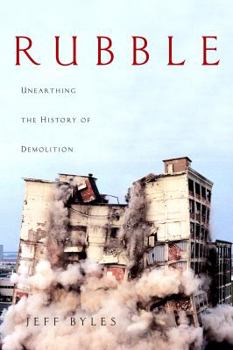Rubble: Unearthing the History of Demolition
Select Format
Select Condition 
Book Overview
From the straight boulevards that smashed their way through rambling old Paris to create the city we know today to the televised implosion of Las Vegas casinos to make room for America's ever grander... This description may be from another edition of this product.
Format:Hardcover
Language:English
ISBN:140005057X
ISBN13:9781400050574
Release Date:November 2005
Publisher:Harmony
Length:353 Pages
Weight:1.28 lbs.
Dimensions:1.4" x 5.9" x 8.5"
Customer Reviews
4 ratings
Grand Story
Published by Thriftbooks.com User , 18 years ago
As one who is fascinated with the old, I thoroughly enjoyed this thought provoking expose about the place "unbuilding" has played in our past and its role in our future. I especially appreciated learning about the role demolition played in the Paris cityscape. I will see Paris in a whole different light the next time I amble through her streets. Very witty examination of an "art" that we see and hear about, but have not delved into either its colorful and varied history or its current affect onour landscape.
Fantastic
Published by Thriftbooks.com User , 18 years ago
It's a history lesson, a technical lesson, poetry, reminiscent, nostalgic, bittersweet, and poignant. Funny, realistic, and lots of footnotes - it's clear he's done his homework! I learned a lot, and enjoyed it thoroughly. A great read - I learned about some of the technical work, and some history and even learned about other countries, and I didn't even realize I was learning - my favorite kind of book. The pictures were awesome.
Loved this Book
Published by Thriftbooks.com User , 18 years ago
This book is not about the technical aspects of demolition or the politics between the players of the industry. It is masterfully researched and documented by 41 pages of reference notes. It is written with matchless wit combined with seriousness and compassion. It touches on all aspects of "unbuilding" which has existed for many centuries. It goes through the early use of pick axe, the wrecking ball, ever-present dynamite to recent "deconstructing" by hand to recycle for future use every possible piece of lumber, brick and fixture. More important, it explains all the reasons why demolition does and has occurred. Some seem valid and others are simply sad. In many ways we cannot blame the demolitionists as they are often reacting to obsolescence created by government, greed by land barons, buildings that were built with a particular life span, or the new fields of play for the demolitionists such as nuclear plant obsolescence and urban asphalt removed to make way for urban living. In short, "it goes to the heart of the scientific, social, economic, and personal meaning of how (and why) we unbuild our world."
A charming and thoroughly researched look at architectural destruction
Published by Thriftbooks.com User , 18 years ago
According to author/journalist Jeff Byles, we can trace the modern history of building demolition to the Great Fire of London in 1666. With remarkable foresight, diarist Samuel Pepys declared that "unless his Majesty did command houses to be pulled down, nothing could stop the fire." Pepys then "hustled home and buried his wine and Parmesan cheese in the garden." When the Lord Mayor ignored the pleas of Pepys and others, citizen activists took matters into their own hands and with "axes, crowbars, ropes and chains" they chopped firebreaks throughout the city. Of such fascinating bits is RUBBLE composed, a charming and exceedingly thorough researching of the subject of purposeful architectural destruction. In the last century, rubbling gained a macabrely festive reputation when entrepreneurs in Las Vegas realized that people would pay to see buildings fall. In a non-city that continually recreates itself, "old" hotels and casinos (30 years is antiquated by Vegas standards) can attract a bigger crowd for their collapse than they did for their opening night. The Vegas "rubble-rousers," as Byles cleverly calls them, have brought razing to a high art, with pyrotechnic displays and lavish pre-show advertising. It's impossible to talk about how a building collapses (it's referred to as "implosion," even though that is, technically speaking, a misnomer) without remembering the World Trade Center's twin towers, the Titanic of the late twentieth century. The towers were skyscrapers whose demise was a sucker punch at the very notion of progress, financial hocus-pocus and technological mega-complexity. Eerie predictions of their ultimate fall were early voiced, with one pundit calling them the "arrogant twins" and another, Cassandra-like, declaring, "There are so many things about gigantism that we don't know." Their doom seemed a foregone and melancholy conclusion to their excess. Another renowned teardown was the Berlin Wall, so poorly built, it turned out, that getting rid of it was accomplished in the main by the modern equivalent of the citizen activists of London's Great Fire. A 6,000-pound section of it was sent intact to Ronald Reagan for his library, undoubtedly making heavy reading. Though there has always been demolition, it is only in recent history that buildings are built with their destruction written into the blueprint. Does this strike anyone as morbid, like tagging each newborn infant with its parent's choice of ultimate disposal? Where is Howard Roark when we need his tormented idealism? But the practice seems logical to a civilization that no longer prides itself on permanency. After all, demolition is a big-buck industry, and the fashions of the city-scape change at our merest whim. Sophisticated subject matter, archly amusing, but sad, sad, sad. --- Reviewed by Barbara Bamberger Scott




